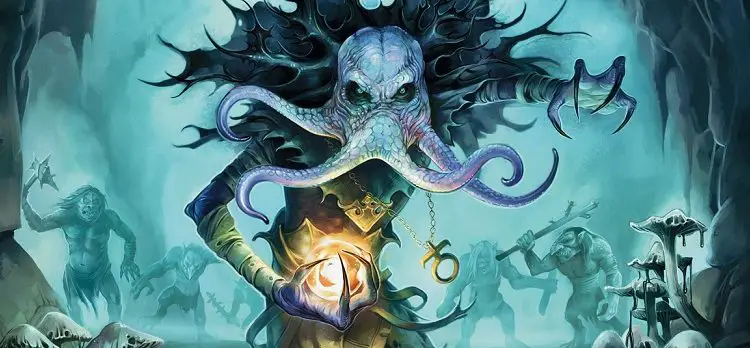Whether you know them as Mind Flayers or Illithids, a tentacled, psionic horror with a taste for brains by any other name would be just as insidious.
While Mind Flayers were once the most powerful beings of the Inner Planes, they have been all but completely wiped out.
Those that still survive have retreated to dark and secretive lairs. There, they scheme and bide their time as they prepare to rise up and reclaim their former glory.
So prepare yourself, dear reader!
Today we take a closer look at one of the most iconic creatures in all of Dungeons & Dragons: the Mind Flayer.
Read on if you dare!
Mind Flayer Physiology
Physical Appearance
Mind Flayers are most immediately recognizable by their octopus-like head with stark, white eyes and four tentacles covering their mouth. Not only does the Illithid have great control of these tentacles, but they can extend outward up to 4 feet in length.
Grabbing their prey with these tentacles, the Mind Flayer holds its victim tight while biting into their head with its small, circular mouth lined with razor sharp teeth.
These creatures’ skin is most commonly varying shades of mauve, though some have a slight greenish hue. They are typically about the same height as most humans and have very thin builds.
Coating the Mind Flayer’s body is a thin layer of slime. This mucus indicates that the creature is healthy and well-nourished.
While an encounter with any Illithid is sure to be dangerous, one that has little or no slime is bound to be particularly hungry…
As far as their clothing, most Mind Flayers dress in styles that are fitting of the Underdark. Deep black robes, skull embellishments, and breastplates are common and add to their menacing appearance.
Communication
Mind Flayers are capable of speech, but they primarily communicate telepathically.
If attempting to speak with multiple creatures, activating a magic item with a command word, or casting a spell that requires verbal components, the Mind Flayer has to improvise a method of speaking. They accomplish this by slithering one of their tentacles down their throat and manipulating it as a type of tongue.
This is uncomfortable for everyone involved in this disgusting spectacle.
Beyond using their telepathy, many Mind Flayers speak Undercommon in addition to any other languages that they might have learned.
Qualith
Qualith is a type of “written language” that Mind Flayers use. However, this doesn’t function like written languages in a way that would make sense to anyone else.
Instead, the Qualith inscriptions psychically transmit the thoughts of the creator to the Mind Flayer that “reads” it by touching the inscription with its tentacles.
Qualith inscriptions are imprinted on nonmagical, nonliving material like stone. These inscriptions create no real changes to the material and, as such, can remain perfectly hidden in plain sight.
The inscriptions use four-line stanzas that must be read simultaneously as interlocked blocks. These patterns are virtually indecipherable by non-Illithid creatures.
It might be possible for someone who touches a Qualith inscription to get a brief “transmission” of the author’s thoughts.
If attempting to decipher a Qualith inscription, a character could make an Intelligence check vs a DC based on how complex the thoughts in the inscription are.
But be careful!
Failure could have any number of results ranging from a small headache to short-term (or even long-term) madness!
For those who are determined to translate a Qualith inscription, the Comprehend Languages spell would give a reasonably accurate understanding of the inscription. There might be some minor differences, but the majority of it should be similar to what a Mind Flayer would learn from the inscription.
Life Cycle
Mind Flayers’ life cycle begins as a batch of parasitic tadpoles that are hatched in Illithid spawning pools.
A single batch can contain around 1000 eggs, though most of these will not reach maturity. The overwhelming majority of these tadpoles are consumed by the Mind Flayer colony’s Elder Brain.
Those that aren’t consumed by the Elder Brain are put into the bodies of the colony’s captive humanoids via the nostril or ear canal. The tadpole burrows into the host’s head, feeding and growing until it has completely replaced the brain and attached itself to the brain stem.
This process is called Ceremorphosis and transforms the host into a Mind Flayer.
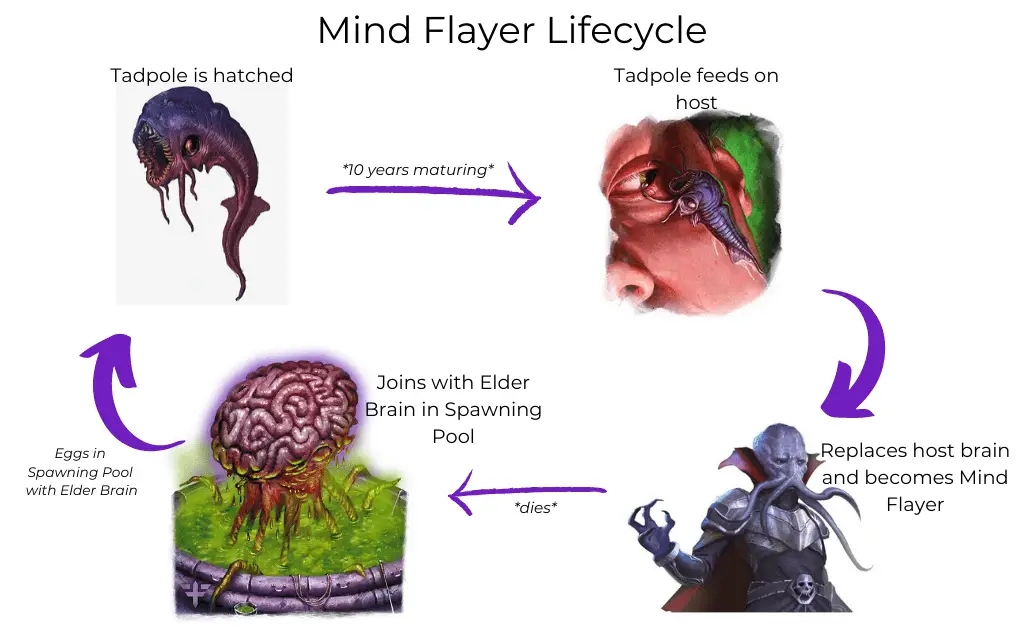
It takes a month for the Mind Flayer eggs to hatch but ten years for the tadpoles to reach the stage of maturity necessary to be implanted in a host. Once the host’s body has been completely taken over, the new Illithid spends the next twenty years growing and being educated in the colony.
Assuming the Mind Flayer lives a full life cycle, they can live up to 135 years.
Upon their death, the Mind Flayer’s body has its brain removed before being put into the spawning pool to be consumed by the Elder Brain.
This is considered a great honor in Mind Flayer society as all of the creature’s knowledge is absorbed by the Elder Brain. Similarly, not being allowed to join the Elder Brain is considered to be a worse punishment than even death.
Brain Food
While the brains of intelligent creatures are used to create more of their kind, Mind Flayers also rely on brains as a food source.
Mind Flayer colonies will commonly be just out of sight of other creatures. If the colony is too far away, they sacrifice having a reliable food source for security. Ideally, the colony is close enough to a settlement of humanoids that there is plenty of brains to feed on but also hidden well enough that they are able to remain largely unbothered.
While the brains that they eat give them some physical sustenance, they are primarily nourished by the psionic energy that is released in the brain’s final moments.
Most commonly, a Mind Flayer will stun its prey with a powerful blast of psychic energy. With the victim unable to move, slimy tentacles wrap around their head and pull them closer to the Illithid’s mouth.
The Mind Flayer’s mouth produces a powerful enzyme that is able to melt through the victim’s skull. Only the mucus that drips from the Illithid’s skin is able to counteract this enzyme.
With the skull weakened and the prey stunned, the Mind Flayer extracts their victim’s brain.
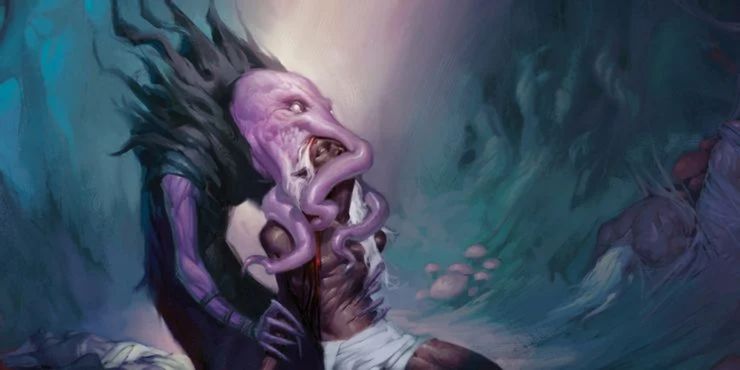
You Are What You Eat
Because Mind Flayers absorb this psionic energy, it can sometimes be possible to tell a lot about their diet based on how they present themselves.
A Mind Flayer that primarily feeds on Elf brains will put more emphasis on wearing elaborate robes and behaving in a certain “elegant” manner. If it feeds heavily on Dwarves, it might display symbols that resemble Dwarven runes on its breastplate or on jars that hold brains that are yet to be used.
On the other hand, a Mind Flayer that primarily feeds on something like Goblins or Grimlocks is unlikely to have these types of priorities.
These lingering traits are subtle and only manifest as a result of large quantities of consumed brains. Nevertheless, it adds a dark undertone to the Mind Flayers’ already chilling demeanor!
The Healthy Illithid
The baseline for survival for a Mind Flayer is being able to eat one brain per month. This isn’t ideal, but it will be able to survive in such conditions.
Particularly healthy Mind Flayers eat one brain every two weeks. In colonies with access to a large food supply, they may be able to eat brains as often as once per week.
Mind Flayers can feed off of the slaves that they keep in their colonies, but are typically hesitant to do so if given a choice.
The slaves take time to mature and are often better used to further grow the colony once the tadpoles have matured. Furthermore, the brains of slaves don’t possess the same amount of psychic energy that the brains of surface-dwelling intelligent creatures have.
Can Mind Flayers Eat Animal Brains?
Everything that is known about Mind Flayers’ diet details their consumption of humanoid brains.
Mind Flayers are physically capable of eating animal brains, but doing so would give them little to no nourishment.
Because only a very small amount of the nourishment that a Mind Flayer receives from eating a brain is from the physical substance of that brain, they are very unlikely to feed on animals. After all, it’s primarily the psionic energy that is possessed by intelligent creatures that Mind Flayers rely on for nourishment.
Think of it like a human eating grass.
You’re physically able to eat the grass, but you won’t enjoy it and you’ll get virtually no nutrients from it. You’d likely much rather have a cheeseburger or some pasta than be expected to be happy eating a handful of grass.
Mind Flayers’ History
There was a time, thousands of years ago, when Illithids were the uncontested dominant power of the Inner Planes.
Traveling throughout the planes on massive flying vessels known as Nautiloids, they would harvest intelligent humanoids from hundreds of worlds within their reach. Some would be devoured, others would be used as slaves, and others would be specifically used to propagate the Illithid race.
Another race, known as the Gith, were particularly relied on for slave labor.
For centuries, the Gith were enslaved by the Illithids until they eventually rose up against the cruel, tentacled tyrants.
Within a single year, the Gith completely destroyed the Mind Flayers’ empire. The Illithids were slaughtered, the Nautiloids were destroyed, and every trace of the empire was reduced to dust.
Not content to stop there, the Gith began sending out hunting parties to locate and wipe out any remaining Mind Flayers that they could find.
Even now, centuries later, the Gith have never stopped their pursuit.
Remnants of the Illithid Empire
Following the Gith uprising, pockets of Mind Flayers still exist.
These colonies exist in vast underground spaces, most notably the Underdark. Despite their numbers, psionic abilities, and ferocity, Mind Flayers stay vigilant in defending their territory and, most importantly, their Elder Brain.
While it is primarily the Gith that they are on guard against, this serves them well against other foes such as Drow raids, miscellaneous terrors of the Underdark, and, of course, adventurers.
Mind Flayers work diligently towards their goal of restoring their once-vast empire. To reclaim the glory that they once had, these beings will spare no expense.
Because they dwell in subterranean lairs close to their food sources, it’s not uncommon for Mind Flayers to begin to meddle with local affairs. Using their psychic abilities to control important figures in local cities (such as rulers or officials), it can be very difficult to tell just how deep an Illithid plot actually goes.
Elder Brains
Nothing is more important to a Mind Flayer colony than the Elder Brain. It’s exactly what you might imagine: a single colossal brain that every Illithid in the colony is linked to.
The Elder Brain’s range for connecting to the colony is typically about 5 miles. Mind Flayers who go beyond that range only do so under strict orders from the Elder Brain.
It can be difficult (if not impossible) to truly tell where the Elder Brain’s influence ends and the Illithid, itself, begins.
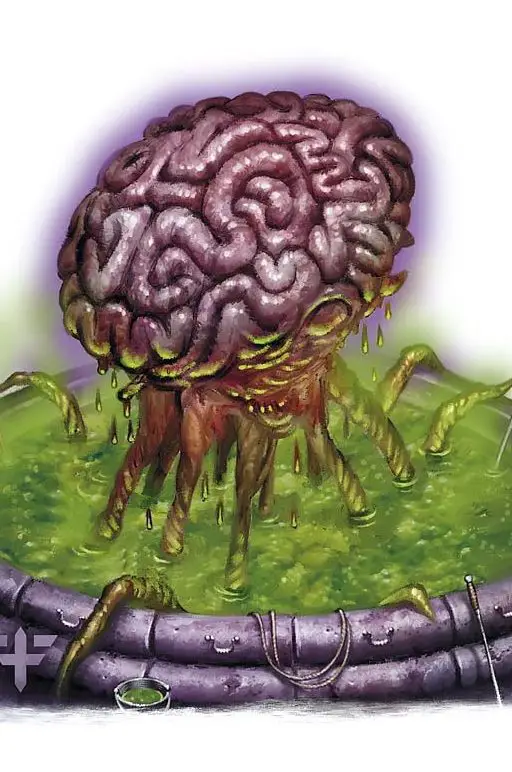
As a scheming and purely evil intellect, the Elder Brain keeps very tight control over the entire colony that surrounds it. In this way, each individual Illithid is simply a small extension of the Elder Brain’s influence.
Each Elder Brain considers itself to be of supreme importance and would hear nothing otherwise. However, they do vary from colony to colony. Some might be cruel and hateful while others are more like impartial sages or living libraries of all of the information the Illithids have collected.
As a giant brain, these beings are all but entirely incapable of movement. They must stay within their pools (where Illithid eggs are hatched) or else they would quickly dry up and wither away.
Mind Flayer Culture
Everything within Mind Flayer culture revolves around serving the Elder Brain. Their minds are all linked together as a network which allows for quick organization and seamless functioning as each Illithid knows its exact role and purpose.
In the same way that the thralls created by a Mind Flayer are perfectly obedient to their master, so the Illithids are completely loyal to their Elder Brain.
This creates a culture of servitude and order in which any level of dissent or intrusion is immediately found and dealt with.
Mind Flayer Alignment
As a collective hivemind based on service to the Elder Brain, it’s no surprise that Mind Flayers are of lawful alignment.
Similarly, because they achieve their goals by enslaving others and… you know… eating brains… they’re pretty uniformly evil across the board.
However, there is one admittedly rare situation where the Lawful Evil alignment may not quite apply…
Can A Mind Flayer Be Good?
Mind Flayers largely stay within their tight-knit colonies and connected to the Elder Brain. However, some situations may arise that cause a Mind Flayer to no longer be under the control of the Elder Brain.
If the connections to the Elder Brain are broken (whether that’s because of their colony being destroyed or some other powerful intervention), an Illithid may find itself going rogue. With free will, it is now able to make decisions for itself and could reasonably choose to be good.
That said, the Gith would not care about the Illithid’s alignment and would still exterminate it on sight. Because of this, it would still be very wary of a Gith hunting party.
Most likely, the Illithid would look to set out and create its own colony for protection in some secretive location. However, it might be less adversarial and could even be a useful ally for the side of good.
Of course, all of this would fly out the window if it finds itself back in proximity of another Elder Brain.
Keep in mind, though, that a “good” Illithid would still need to eat brains. It might be fine with evil creatures of some intelligence, but it’s up to you if that’s possibly still too cruel of a fate…
Just don’t mistake a Mind Flayer that claims to be good as being entirely genuine. Keep in mind that they are very intelligent manipulators who may even seek to cultivate sympathy before ultimately devouring your brains once they have your trust.
The Grand Design
In keeping with the goals of the Elder Brain, a Mind Flayer colony focuses on building a secure base of operations before beginning the work that they believe will restore their empire.
As incredibly intelligent creatures, they gather as much knowledge about the world as possible. Funneling all of this information into the Elder Brain as a type of massive repository of information, the colony focuses in perfect unison on their goals.
Some of these goals may be massive undertakings while others may seem simple by comparison. Nevertheless, any and all information is of use to the Illithids and their pursuit of the Grand Design.
Goals and Strategy
Mind Flayers’ goals are entirely dependent on that of the Elder Brain that controls them. What one colony views as the top priority towards the Grand Design may not even be a consideration of another colony.
Some goals might include:
- Construction of some method to repel and destroy the Gith
- Rediscovering the secrets of building Nautiloids
- Optimizing the flow of intelligent visitors to their lair as a food source. (Possibly via political influence, sowing rumors of ancient magic/ruins that would appeal to intellectuals, or even just dropping an entire city into the Underdark)
When attempting to conquer a humanoid settlement, one of three strategies is used by Illithids to achieve their goals.
They might seek to outright control the settlement’s population by turning the citizens into mindless thralls. If they can’t safely infiltrate the city, the Mind Flayers might instead focus on amplifying their Elder Brain’s powers to begin influencing the innocent people of the settlement that way.
On the other hand, it might be more efficient for the Mind Flayers to take control of a few key aspects of the settlement. Sabotaging the community from the shadows, they can orchestrate a steady decline as the settlement is destroyed from within and, therefore, incapable of defending against the Mind Flayers’ assault.
Lastly, the Elder Brain might instead dictate that total destruction is the answer. Releasing plagues, famine, and natural disasters upon the population, the goal becomes total annihilation.
To gain further knowledge of the settlement’s weaknesses, the Mind Flayers learn all they need to know by eating the brains of stragglers who live there.
Magic and Psionic Powers
Mind Flayers have very powerful psionic abilities that are the foundation of their abilities.
These range from their telepathic communication to their Mind Blast ability to their ability to create thralls.
Some Mind Flayers (such as the Mind Flayer Psion variant in Volo’s Guide to Monsters) dedicate themselves entirely to refining their innate psionic abilities. These Illithids are able to mimic certain spells purely with their own psionic abilities.
Others, however, might take an interest in studying Arcane magic.
While these are rare (and usually shunned within their own colonies), the mixture of psionic and arcane abilities make Mind Flayer Arcanists (on page 222 of the Monster Manual) particularly dangerous.
Minions and Monsters
Mind Flayers are very rarely encountered alone even though encountering multiple Mind Flayers at a single time is somewhat rare.
Because of their ability to create thralls, any Mind Flayer that is going any distance away from the colony will have some extra protection.
Most commonly, these thralls are captured humanoids, Duergar, Grimlocks, Kuo-Toa, and Quaggoths. Of course, anything that ventures too close to the Illithids’ grounds might be forced to serve as a thrall.
Imagine what could be done with an Ogre thrall!
Of course, the experiments conducted by Mind Flayers have also led to the creation of additional creatures that adventurers should be wary of.
For instance, a Beholder that has been implanted with an Illithid tadpole becomes a creature known as a Mindwitness. (Think of it as a beholder with less eyes and more tentacles that serves as an amplifier for the Elder Brain’s psychic connections.)
Other such creations include Neothelids (a tadpole that is never implanted in a host that grows unchecked until it is as gargantuan as a Purple Worm and, somehow, even more hungry) and the infamous Intellect Devourers (which made our list of 12 Monsters That Will Instantly Kill Your Characters).
Variations of Mind Flayers
With Mind Flayers being one of the original iconic monsters from the very earliest days of Dungeons & Dragons, there is no shortage of variations on these creatures.
However, the primary variations that have been officially published in the 5e materials at this point include:
- Mind Flayer Arcanist – A Mind Flayer that mixes arcane magic with its own psionic abilities to dangerous effect.
- Mind Flayer Psion – A Mind Flayer that has amplified its psionic abilities to further mimic other arcane spells in inventive ways.
- Alhoon (Illithilich) – A Mind Flayer that has been exiled from its colony for pursuing studies of Arcane magic and successfully undergone a uniquely-Illithid process of becoming a lich.
- Ulitharid – A very rare but powerful type of Mind Flayer that is capable of starting its own colony and becoming an Elder Brain itself.
Mind Flayers in Your Game
Whew! There’s a lot to Mind Flayers, eh?
Now that we’ve covered what they are, let’s get into the practical stuff: how they affect your game!
Fighting Against Mind Flayers
Mind Flayers have great mental stats, but they are lacking in physical abilities. With low Strength, Dexterity, and Constitution, one could be brought down if you’re able to quickly dogpile it.
However, the Mind Flayer’s Mind Blast ability could potentially stun an entire party and directly lead to one or more characters dying.
Spells that allow the target to make saving throws aren’t going to be very effective in this fight (at least not against the Mind Flayer itself) thanks to the tentacled ones’ natural resistance to magical effects. Though trusty spells like Magic Missile or Fire Bolt will help you lay down some damage from a safe distance.
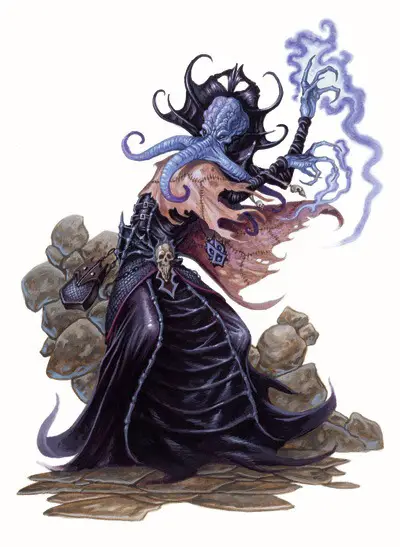
The biggest threats when fighting a Mind Flayer (not including its allies in the fight) are its Mind Blast and Dominate Monster abilities.
With Mind Blast, the Mind Flayer will have no difficulty at all extracting the brain of at least one character. Needless to say, that character will be very dead if this happens…
Likewise, if the Mind Flayer is able to successfully use Dominate Monster on one of your party members, things can go bad very quickly.
Ultimately, you want to have a strategy and be able to execute on it quickly. If possible, try to keep a safe distance and don’t be afraid to use your Inspiration when the Illithid uses its Mind Blast if you have it.
Ranged combatants like archers are your best bet when fighting a Mind Flayer. They’re able to keep a safe distance, use the terrain to their advantage, and keep their target locked down with a storm of arrows.
The longer a fight with a Mind Flayer goes on, the less likelihood there is of you getting away.
Also, as one user points out here on Stack Exchange, use spells like Protection from Evil and Good to better resist the Mind Flayer’s attacks and be immune to the Charm effect from Dominate Monster. (Even though that discussion is about Pathfinder, this advice still applies in 5e!)
Using Mind Flayers as a DM
Mind Flayers are incredibly intelligent and very well-informed.
If combat is unavoidable for a Mind Flayer, you can absolutely bet that it’s prepared. With a few thralls or even a couple of Intellect Devourers, the fight can quickly become deaadly for the party.
The Mind Flayer will look for the quickest ways to incapacitate the biggest threats. Mercy isn’t in the Illithid playbook, so don’t be afraid to be ruthless with its tactics!
After all, as a creature with a 19 Intelligence, the Mind Flayer should absolutely play strategically.
If the party is clustering together, the stun effect from its Mind Blast will make them into sitting ducks. A 60 foot cone can be devastating!
Otherwise, dominating the heaviest hitter and turning them against their allies can do the trick.
Though, you might also consider having the Mind Flayer dominate the party’s ranged attacker instead. Not only does the Mind Flayer gain an ally, but the party’s best counter to the Mind Flayer’s tactics isn’t on their side anymore!
If you want to get extra tactical when using a Mind Flayer, I’d suggest grabbing a copy of The Monsters Know What They’re Doing. You’ll have a hard time not letting out the classic “mad scientist laugh” when you plan the encounter with this book’s help.
You can learn more about TMKWTD in my review.
Treasure
After a hard-fought battle with a Mind Flayer or, even harder still, a colony, the party probably is expecting some kind of epic treasure horde.
Unfortunately, Mind Flayers don’t particularly care about treasure in that way. Piles of gold and precious gems mean nothing to them and don’t serve to further their agenda.
I get it, but it kind of feels like a gut punch to go through such a difficult fight only to receive nothing.
While a ton of wealth doesn’t particularly make sense, I would suggest looking at options for magical items that you can give the party as a reward.
Perhaps the Mind Flayers were attempting to study the magical items or they were thrown to the side as the previous owner had their brain devoured.
For surviving their encounter with such a terrifying being, the characters absolutely deserve some kind of reward beyond the warm-fuzzies they get for making the land at least a little safer.
Conclusion – Mind Flayers in D&D 5e
What can I say? There’s a lot to Mind Flayers!
It’s no wonder why these have been around so long! They’re terrifying but also just oozing with so much lore. Because of their method of operating, they can pretty easily be inserted to just about any campaign without it feeling overly forced.
Have you ever used or fought against a Mind Flayer in your games?
Tell me how that went in the comments below!
Until next time!

